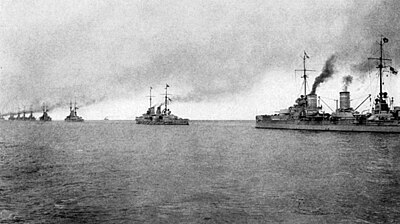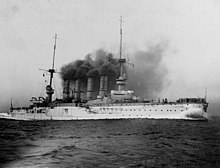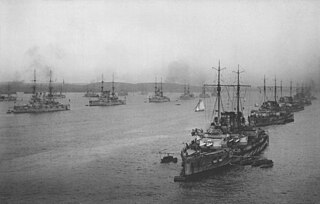
The Imperial German Navy or the Kaiserliche Marine was the navy of the German Empire, which existed between 1871 and 1919. It grew out of the small Prussian Navy, which was mainly for coast defence. Kaiser Wilhelm II greatly expanded the navy. The key leader was Admiral Alfred von Tirpitz, who greatly expanded the size and quality of the navy, while adopting the sea power theories of American strategist Alfred Thayer Mahan. The result was a naval arms race with Britain, as the German navy grew to become one of the greatest maritime forces in the world, second only to the Royal Navy.

The Mackensen class was the last class of battlecruisers to be built by Germany in World War I. The design initially called for seven ships, but three of them were redesigned as the Ersatz Yorck class. Of the four ships of the Mackensen class, Mackensen, Graf Spee, and Prinz Eitel Friedrich were launched, and Fürst Bismarck was not—but none were completed, after wartime shipbuilding priorities were redirected towards U-boats—and the ships were broken up in the early 1920s. The lead ship of the class was named for August von Mackensen, a prominent military commander during the war. In response to the Mackensen-class ships, the British Royal Navy laid down the Admiral-class battlecruisers, all but one of which would eventually be cancelled; the sole survivor, HMS Hood, was completed after the end of the war.
Aktien-Gesellschaft Vulcan Stettin was a German shipbuilding and locomotive building company. Founded in 1851, it was located near the former eastern German city of Stettin, today Polish Szczecin. Because of the limited facilities in Stettin, in 1907 an additional yard was built in Hamburg. The now named Vulcan-Werke Hamburg und Stettin Actiengesellschaft constructed some of the most famous civilian German ships and it played a significant role in both World Wars, building warships for the Kaiserliche Marine and the Kriegsmarine later.

SMS König Wilhelm was an armored frigate of the Prussian and later the German Imperial Navy. The ship was laid down in 1865 at the Thames Ironworks shipyard in London, originally under the name Fatih for the Ottoman Empire. She was purchased by Prussia in February 1867, launched in April 1868, and commissioned into the Prussian Navy in February 1869. The ship was the fifth ironclad ordered by the Prussian Navy, after Arminius, Prinz Adalbert, Friedrich Carl, and Kronprinz. She was built as an armored frigate, armed with a main battery of sixteen 24 cm (9.4 in) and five 21 cm (8.3 in) guns; several smaller guns and torpedo tubes were added later in her career.

Kaiserliche Werft Kiel was a German shipbuilding company founded in 1867, first as Königliche Werft Kiel but renamed in 1871, with the proclamation of the German Empire. Together with Kaiserliche Werft Danzig and Kaiserliche Werft Wilhelmshaven it was one of three shipyards which produced warships for the Preußische Marine and later the Kaiserliche Marine. With the end of World War I Kaiserliche Werft Kiel was closed but the shipyard was opened again when Deutsche Werke was founded on their grounds in 1925.

Kaiserliche Werft Wilhelmshaven was a German shipbuilding company in Wilhelmshaven, founded in 1871 and closed in 1918. Together with Kaiserliche Werft Danzig and Kaiserliche Werft Kiel it was one of three shipyards which solely produced warships for the Preußische Marine and the following German Kaiserliche Marine. With the end of World War I all three imperial shipyards were closed, but the Wilhelmshaven shipyard was reopened in 1919, first as Reichsmarinewerft Wilhelmshaven, and after 1935 named Kriegsmarinewerft Wilhelmshaven.

SMS Kaiser Wilhelm der Grosse was a German pre-dreadnought battleship of the Kaiser Friedrich III class, built around the turn of the 20th century. The ship was one of the first battleships built by the German Imperial Navy as part of a program of naval expansion under Kaiser Wilhelm II. Kaiser Wilhelm der Grosse was built in Kiel at the Germaniawerft shipyard. She was laid down in January 1898, launched in June 1899, and completed in May 1901. The ship was armed with a main battery of four 24-centimeter (9.4 in) guns in two twin turrets.

The Prinz Adalbert class was a group of two armored cruisers built for the German Kaiserliche Marine under the terms of the Second Naval Law. Two ships of the class were built, Prinz Adalbert and Friedrich Carl, between 1900 and 1904. The two ships were heavily based on the previous armored cruiser, Prinz Heinrich, with a series of incremental improvements. Their armor layout was revised slightly to improve internal protection and their main battery consisted of four 21 cm (8.3 in) guns instead of the two 24 cm (9.4 in) carried by Prinz Heinrich. The new ships also received more powerful propulsion systems, making them slightly faster. Prinz Adalbert spent her peacetime career as a gunnery training ship while Friedrich Carl initially served as the flagship of the fleet's reconnaissance forces. By 1909, she had been replaced by more modern cruisers and joined Prinz Adalbert as a training vessel.

SMS Friedrich Carl was a German armored cruiser built in the early 1900s for the German Kaiserliche Marine. She was the second and final member of the Prinz Adalbert class, which was built to provide scouts for the German fleet and station ships in Germany's colonial empire. Friedrich Carl was built by the Blohm & Voss shipyard in Hamburg. She was laid down in August 1901, launched in June 1902, and commissioned in December 1903. She was armed with a main battery of four 21 cm (8.3 in) guns and could reach a top speed of 20 knots.

SMS Prinz Adalbert was an armored cruiser built in the early 1900s for the Imperial German Navy. She was named after Prince Adalbert of Prussia, former Commander-in-Chief of the Prussian Navy, and was the lead ship of her class.

SMS Prinz Heinrich was a unique German armored cruiser built at the turn of the 20th century for the German Kaiserliche Marine, named after Kaiser Wilhelm II's younger brother Prince Heinrich. The second vessel of that type built in Germany, Prinz Heinrich was constructed at the Kaiserliche Werft in Kiel, being laid down in December 1898, launched in March 1900, and commissioned in March 1902. Prinz Heinrich's design was a modification of the previous armored cruiser, Fürst Bismarck, and traded a smaller main battery and thinner armor for higher speed. All subsequent German armored cruisers were incremental developments of Prinz Heinrich.

SMS Kronprinz was a unique German ironclad warship built for the Prussian Navy in 1866–1867. Kronprinz was laid down in 1866 at the Samuda Brothers shipyard at Cubitt Town in London. She was launched in May 1867 and commissioned into the Prussian Navy that September. The ship was the fourth ironclad ordered by the Prussian Navy, after Arminius, Prinz Adalbert, and Friedrich Carl, though she entered service before Friedrich Carl. Kronprinz was built as an armored frigate, armed with a main battery of sixteen 21 cm (8.3 in) guns; several smaller guns were added later in her career.

SMS König Albert was the fourth vessel of the Kaiser class of dreadnought battleships of the Imperial German Navy. König Albert's keel was laid on 17 July 1910 at the Schichau-Werke dockyard in Danzig. She was launched on 27 April 1912 and was commissioned into the fleet on 31 July 1913. The ship was equipped with ten 30.5-centimeter (12 in) guns in five twin turrets, and had a top speed of 22.1 knots. König Albert was assigned to III Battle Squadron and later IV Battle Squadron of the High Seas Fleet for the majority of her career, including World War I.
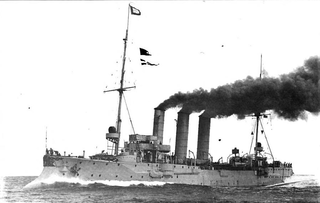
SMS Lübeck was the fourth of seven Bremen-class cruisers of the Imperial German Navy, named after the city of Lübeck. She was begun by AG Vulcan Stettin in Stettin in 1903, launched in March 1904 and commissioned in April 1905. Armed with a main battery of ten 10.5 cm (4.1 in) guns and two 45 cm (18 in) torpedo tubes, Lübeck was capable of a top speed of 22.5 knots.

SMS Friedrich Carl was an ironclad warship built for the Prussian Navy in the mid-1860s. The ship was constructed in the French Société Nouvelle des Forges et Chantiers de la Méditerranée shipyard in Toulon; her hull was laid in 1866 and launched in January 1867. The ship was commissioned into the Prussian Navy in October 1867. The ship was the third ironclad ordered by the Prussian Navy, after Arminius and Prinz Adalbert, though the fourth ship to be acquired, Kronprinz, was ordered after but commissioned before Friedrich Carl.
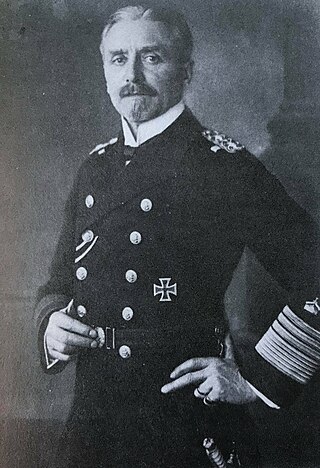
Gustav Bachmann was a German naval officer, and an admiral in World War I. He headed the German Imperial Admiralty Staff briefly from February 1915, before being forced out in September 1915 over the failure of the first round of unrestricted submarine warfare.


